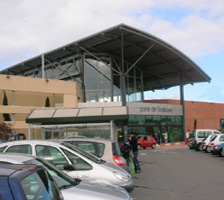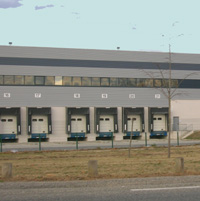( © Created by Philippe IMBERT – Atelier des taxes
locales )
The registry
rental value of a building in France is the normal annual rent of the building when it
is rented to market conditions. The French registry rental value (“Valeur locative
cadastrale”, or VLC) is the rental value calculated in accordance with the
rules for determining the assessment basis of real property taxes in France.
To calculate
the registry rental value, what the audit of local taxes will have to realise,
we should not consider the current rental value of the property, but we should
base on the normal rent that could produce the building on the 1st
of january 1970.
The registry
rental value is calculated by land registry evaluation unit, the unit being
the premises, which is a property or a fraction of property subject to a
separate use.
There are
different sorts of registry rental values : for commercial premises, for
professional premises, for industrial premises and for residential use
premises.
|
The
registry rental value of professional premises
and residential use premises
|
According to
Article 324 H of Annex III of the French
 general tax code (CGI) :
general tax code (CGI) :
*
"I-
For detached houses and premises located in a collective building, the
communal classification is based on a nomenclature in eight categories,
adapting to the local standards of construction the general criteria listed in
the table below.
II- For
built remote outbuildings and other items specified in Article II of 324 G,
the communal classification is based on a special nomenclature in four
categories, adapting to the local standards of construction the general
criteria described the table below.
III- In
both cases I and II, may be created some intermediate categories that will
combined, in simple proportions, two catégories-types.
IV- The
physical characteristics associated with each type and category of premises
identified in the communal classification are listed in the report of the
review operations."
(*
unofficial translation)
Each
municipality establishes a classification for the premises located on its
area,
During the
overhaul of 1970, all the owners of buildings and premises had to fill in a
form.
Since this
overhaul, the owners of buildings and premises must indicate in a special file
to the administration all the new constructions, additions to existing
structures (Art of CGI 1406), changes in consistency and changes of
assignment, within the 90 days of realization of the change.
Among
all the premises, some reference premises are selected and evaluated,
Calculation
of the weighted surface,
Take the real
surface and use modifications based on the size of the building, the elements
of comfort, the nature of the rooms, the elements of comfort, the state of
maintenance of the building, the situation of the building in the
municipality, etc.
Use of a
patch of importance,
.This
patch modifies the surface by assigning a coefficient based on the number of
m2.
Weight of the
secondary elements,
The
coefficient weighting the size of secondary elements ranges from 0,1 to 0,6,
depending on the value of each secondary element.
Use of an
overall patch,
Application
of the surface equivalences,
Some items of
equipment give rise to a superficial equivalence, which means an equivalence
in square meters (a bath : 5 m2, a shower : 4 m2, a cooling system : 2 m2,
etc.).
Calculation
of the total weighted surface,
Use an
evaluation
tariff on the total weighed surface
The tariff is
determined from a study of the existing rents in the municipality in January 1st
1970.
The
result is the registry rental value.
The
professional premises (premises used by some professional independent people,
like doctors in medicine, dentists, lawyers, chartered accountants, insurance
agents, …) follow the same method to evaluate the registry rental value than
the residential use premises.
|
The
registry rental value of commercial premises
|
Article 1498
of the French general tax code (CGI) explains the registry rental value of
commercial premises and some other premises
(Law No. 2003-1312, 30th December 2003, art. 43§2 Supplementary Budget
for 2003 Official Journal 31st December 2003) :
*
"The rental
value of all goods other than the premises referred to in Article I of 1496
and the industrial establishments under Article 1499 is determined using one
of the methods listed below:
1
º For goods on hire at normal price conditions, the rental value is the one
that emerges from this location;
2º a.
For
properties leased with abnormal price conditions or owner-occupied, or
occupied by a third party without a rent, or vacant, or rented for free, the
rental value is determined by comparison.
The
terms of comparison are chosen in the municipality.They
may be chosen out of the municipality to evaluate buildings with a particular
or exceptional character;
b.The
rental value of comparative reference premises is fixed :
Either
from current lease on the reference date of the revision when the building had
a normal leased at this date,
Or,
if not, in comparison with similar buildings located in the municipality or in
a municipality which has, from an economic point of view, a similar situation
to that municipality situation and who were located at that time with normal
price conditions;
3
º Outside these above basis, the rental value is determined through direct
assessment. "
(* unofficial
translation)
Three methods
are used to fix the registry rental
value of commercial premises.
1 -
Determination of the rental value by the leases study
"1
º For goods on hire at normal price conditions, the rental value is the one
that emerges from this location;”
If the
premises are rented at normal conditions, and if the premises were existing
and hired on January 1st, 1970, the registry rental value of 1970
is equal to the rent charged at that time.
are rented at normal conditions, and if the premises were existing
and hired on January 1st, 1970, the registry rental value of 1970
is equal to the rent charged at that time.
But we have
to verify whether the local is rented at normal price conditions. It is
therefore important to be able to compare with a reference building. We choose
a reference building and we determine the amount of weighted m2 of this
reference building. If the amount of the weighted m2 of your building is
between 80% and 120% of the total amount of the weighed m2 of the reference
building, the rent of your building is considered as normal.
In this case,
"the rental value is the one that emerges from this location." Then, we
will update the rental value of 1970 by using a set of two coefficients.
If the
premises did not exist on January 1st 1970, or has a different
consistency or use, the determination of the registry rental value by the
lease study is not possible.
2 –
Determination
of the rental value by the comparison
method
« 2º a. For
properties leased with abnormal price conditions or owner-occupied, or
occupied by a third party without a rent, or vacant, or rented for free, the
rental value is determined by comparison.
The terms
of comparison are chosen in the municipality.
They may be chosen out of the municipality to evaluate buildings with a
particular or exceptional character;”
The
determination of the rental value by comparison is used for the majority of
the premises
For
properties leased in conditions of abnormal price,
For property
owner-occupied,
For property
occupied by a third party without a rent,
For vacant
property,
For premises
rented for free.
It is
necessary to determine the weighted surface of the premises to assess.
The French
tax administration agents are choosing a reference building to compare with
the owner’s building, with a fixed tariff. They multiply the tariff of the
reference building by the number of weighted m2 of the building to evaluate.
The choice of the reference building can be discussed.
Usually the
reference building is chosen in the municipality where is the building to
assess. However, the
reference building can be selected outside the municipality, if it "has a
particular or exceptional character."
For example:
several municipalities do not have any hypermarket, and few have two
hypermarkets. It may be necessary to search outside the municipality to find
the reference premises. Then, we have to update the registry rental value of
1970 by using a set of two coefficients :
update
between 1970 and 1980, based on the county (“département”) coefficient;
upgrading
from 1981 to 2007 based on the national coefficient.
3 -
Determination of the rental value by direct assessment : the method when the
two other methods are inapplicable.
"3 º If
these bases are not applicable, the rental value is determined through direct
assessment."
First,
estimate of the market value of the building on January 1st 1970.
Several ways
exist to determine this fair value :
- Selling
price in close sales contracts,
- Discounted
sale price in acts of old selling contracts,
- Cost of
reconstruction of the building on which is applied a depreciation.
Then,
determination of the interest rate applicable to that market value.
The interest
rate has to be the average rate of real estate in the municipality.
Again, the registry rental value of 1970 must be then updated.
|
The
registry rental value of industrial premises
|
There are two
main types of industrial premises :
Factories
and manufacturing, processing or repair workshops;
Premises
where are realised extraction, handling or services operations, in which are
mainly used motive power and tools.
The offices
and premises of minor importance belonging to the same industrial centre are
also treated as industrial premises (except residential use premises).
1 - The
determination of the registry rental value by the accounting method
Article 1499
of French general tax code (CGI) concerns the registry rental value of
industrial premises : * "The rental value of industrial assets liable to
the real property tax on developed land is determined by applying on the cost
price of their various components, adjusted with factors that had been planned
for the revision of the balance sheets, the interest rates set by decree by
the Conseil d’Etat.
Before
eventual use of these factors, the cost price of the land is increased by 3%
for each year since the entry of the component in the heritage of the owner.
A decree of
the Conseil d’Etat sets the abatement rates applicable to the registry rental
value of the buildings and of the installations to accommodate the date of
their entry into the assets of the company.
the registry rental
value of the buildings and of the installations to accommodate the date of
their entry into the assets of the company.
An additional
deduction is also given to certain categories of premises because of their
exceptional nature, which is based on the nature of the operations realised;
These types of premises are determined by a decree of the Conseil d’Etat that
also sets limits and conditions for the application of the deduction. "
(* unofficial translation)
The rental
value of industrial premises is mainly based on accounting data, concerning
mainly the cost price of the land, buildings, equipment and tools.
Article 324
AE of Annex III of French general tax code (CGI) explains : * "The cost
price referred to in Article 1499 of the General Tax Code means the original
value for which the assets should be included in the balance sheet in line
with the Article 38 quinquies of the present Annex.
No
correction is made to such values to take into account the taxes on turnover
(value added tax) supported by the company.
The
original value to take into account is the total cost price prior outstanding
deductions and special depreciations allowed in tax matters.
It
is similar for assets partially reassessed or depreciated for the total or for
a part of them. "
(* unofficial
translation)
The article
324 AF of Annex III of French general tax code (CGI) adds : *"When it does
not come from the balance sheet, the cost price is determined, as appropriate,
by all the accounting records or other documentary evidences and, if not
possible, through assessment subject to the right of supervision by the
administration. "
(* unofficial
translation)
From the cost
price are used revaluation coefficients and rebates :
Reevaluate
assets bought or created before January 1st 1959 according to a
revision coefficient of the balance sheets.
Add 3%
on the cost price of the land per year, since the entry in the heritage.
Calculate on
the cost price reassessed an interest rate (8% on land and 12% on buildings
and facilities).
The result of
these three operations gives the gross registry rental value of the industry
premises.
Calculate
on the gross
registry rental value a 25% abatement (property acquired or created before
1976) or a 33% abatement (property acquired or created since January 1st
1976) to reflect the length of ownership.
The result of
this new operation is the registry rental value of the industrial premises.
2 - The
determination of the registry rental value by the particular method
Under Article
1500 of French general tax code (CGI), * "By derogation to Article 1499,
buildings and industrial lands that are not included in the assets of an
industrial or commercial company bound by the obligations set out in Article
53A, are evaluated as specified in Article 1498. "
(*
unofficial translation)
Companies
that fall under the package system regime of taxation, even if they opt for
the real system of taxation can not use the accounting method and therefore
have to use the particular method for the determination of the registry rental
value.
This
particular method consists in measuring the registry rental value of
industrial premises according to the valuation rules for commercial premises,
which means determining the rental value or by the study of the leases, or by
comparison with a reference building, or through direct assessment.
The
determination of the rental value by the study of the leases is only possible
if the premises were existing on January 1st 1970. However, the
premises must have been rented with normal conditions.